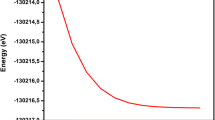Abstract
The structural α-γ transition in iron has been studied in the framework of the GGA + DMFT method using the generalized gradient approximation (GGA) and the dynamical mean field theory (DMFT). The impurity problem in the DMFT has been solved using the recently proposed method based on the Hirsch-Fye algorithm and approximately taking into account the rotational invariance of the Coulomb interaction. It has been shown that a decrease in the calculated Curie-Weiss temperature is accompanied by a decrease in the calculated α-γ transition temperature if one takes into account the rotational invariance of the Coulomb interaction. Moreover, the agreement between the calculated α-γ transition temperature and its experimental value is improved. The results obtained agree with the earlier proposed explanation of the mechanism of this transition, according to which its main driving force is the magnetic correlation energy.
Similar content being viewed by others
References
W. Kohn and L. J. Sham, Phys. Rev. 145, 561 (1966).
D. J. Singh, W. E. Pickett, and H. Krakauer, Phys. Rev. B: Condens. Matter 43, 11628 (1991).
L. Stixrude, R. E. Cohen, and D. J. Singh, Phys. Rev. B: Condens. Matter 50, 6442 (1994).
E. G. Moroni, G. Kresse, J. Hafner, and J. Furthmuller, Phys. Rev. B: Condens. Matter 56, 15629 (1997).
V. I. Anisimov, A. I. Poteryaev, M. A. Korotin, A. O. Anokhin, and G. Kotliar, J. Phys.: Condens. Matter 9, 7359 (1997).
V. Anisimov and Yu. Izyumov, Electronic Structure of Strongly Correlated Materials (Springer-Verlag, Berlin, 2010).
A. I. Lichtenstein, M. I. Katsnelson, and G. Kotliar, Phys. Rev. Lett. 87, 067205 (2001).
M. Katsnelson and A. Lichtenstein, J. Phys.: Condens. Matter 11, 1037 (1999).
I. Leonov, A. I. Poteryaev, V. I. Anisimov, and D. Vollhardt, Phys. Rev. Lett. 106, 106405 (2011).
I. Leonov, A. I. Poteryaev, V. I. Anisimov, and D. Vollhardt, Phys. Rev. B: Condens. Matter 85, 020401(R) (2012).
I. Leonov, A. I. Poteryaev, Yu. N. Gornostyrev, A. I. Lichtenstein, M. I. Katsnelson, V. I. Anisimov, and D. Vollhardt, Sci. Rep. 4, 5585 (2014).
A. A. Katanin, A. I. Poteryaev, A. V. Efremov, A. O. Shorikov, S. L. Skornyakov, M. A. Korotin, and V. I. Anisimov, Phys. Rev. B: Condens. Matter 81, 045117 (2010).
V. I. Anisimov, A. S. Belozerov, A. I. Poteryaev, and I. Leonov, Phys. Rev. B: Condens. Matter 86, 035152 (2012).
A. S. Belozerov, I. Leonov, and V. I. Anisimov, Phys. Rev. B: Condens. Matter 87, 125138 (2013).
A. S. Belozerov and V. I. Anisimov, J. Phys.: Condens. Matter 26, 375601 (2014).
A. Georges, G. Kotliar, W. Krauth, and M. J. Rozenberg, Rev. Mod. Phys. 68, 13 (1996).
A. N. Rubtsov, V. V. Savkin, and A. I. Lichtenstein, Phys. Rev. B: Condens. Matter 72, 035122 (2005).
R. Bulla, T. A. Costi, and T. Pruschke, Rev. Mod. Phys. 80, 395 (2008).
M. Caffarel and W. Krauth, Phys. Rev. Lett. 72, 1545 (1994).
J. E. Hirsch and R. M. Fye, Phys. Rev. Lett. 56, 2521 (1986).
A. L. Fetter and J. D. Walecka, Quantum Theory of Many-Particle Systems (McGraw-Hill, New York, 1971).
A. K. McMahan, K. Held, and R. T. Scalettar, Phys. Rev. B: Condens. Matter 67, 075108 (2003).
J. P. Perdew, K. Burke, and M. Ernzerhof, Phys. Rev. Lett. 77, 3865 (1996).
Z. S. Basinski, W. Hume-Rothery, and A. L. Sutton, Proc. R. Soc. London, Ser. A 229, 459 (1955).
Author information
Authors and Affiliations
Corresponding author
Additional information
Original Russian Text © A.S. Belozerov, V.I. Anisimov, 2015, published in Fizika Tverdogo Tela, 2015, Vol. 57, No. 7, pp. 1255–1259.
Rights and permissions
About this article
Cite this article
Belozerov, A.S., Anisimov, V.I. Structural α-γ transition in iron within the GGA + DMFT method taking into account the rotational invariance of the Coulomb interaction. Phys. Solid State 57, 1277–1281 (2015). https://doi.org/10.1134/S1063783415070069
Received:
Published:
Issue Date:
DOI: https://doi.org/10.1134/S1063783415070069




